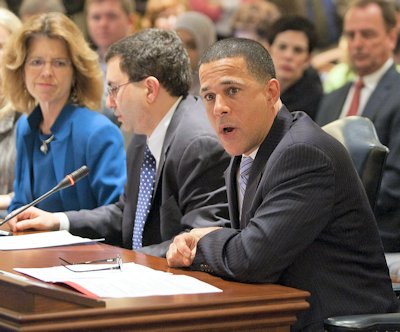
From right: Lt. Gov. Anthony Brown, Health Secretary Joshu Sharfstein and director of health care reform Carolyn Quattrocki testify on legislation in 2012 (Photo: MdGovPics)
Let’s face it: Maryland dropped the ball on implementing Obamacare. To date the rollout has been a failure. Thirty-seven hundred sign-ups since October 1. That’s pathetic.
Who bears ultimate responsibility?
Let’s start at the top with Gov. Martin O’Malley and his designated point man on the healthcare rollout, Lt. Gov. Anthony Brown. Ever since 2010, Brown has promoted his leadership role in the Obamacare implementation.
The lieutenant governor co-chairs the Health Care Reform Coordinating Council responsible for spending $173 million in federal funds on an internet signup website.
Until recently, he’s been quick to take credit for this initiative’s potential to extend health care to more of the state’s 800,000 uninsured.
Missing in action?
Yet when the Maryland Healthcare Connection computer system froze, the lieutenant governor was nowhere to be found. Emails released to the Baltimore Sun confirm Brown was a no-show in keeping on top of this vitally important state technology program.
When Maryland’s connector system crashed and continued malfunctioning, Brown let others take the heat.
At a Senate Finance Committee hearing to discuss systemic problems plaguing the state’s botched website, Brown was absent. Instead, it was Health Secretary Josh Sharfstein who had to admit there’s no telling when the state’s website will be glitch-free.
It was Sharfstein, not Brown, who had to admit there’s nothing the state can do to help people who are losing their healthcare benefits through no fault of their own.
A similar scenario played out before a House committee in Annapolis. Brown remained AWOL.
Then on Wednesday, WBAL-TV’s ace reporter Jayne Miller tracked down Brown and asked about his responsibility for the health care signup mess. She got an aggressive brush-off from a man who sounded offended that his leadership was being questioned.
Brown caught a break Friday when Rebecca Pearce, executive director of the troubled health exchange, resigned after O’Malley sent in his staff to oversee the crippled IT operation.
Pearce is a scapegoat
Now Brown has a scapegoat. Yet he’s having increasing difficulty responding to criticisms that he was too busy campaigning to bother with the nitty-gritty of this IT implementation.
He’s promised to address all this at a carefully scripted and rehearsed press conference sometime this week — if he can fit it into his busy campaign schedule.
Brown’s campaign advertises that he is a proven leader. His websites brag about his role in bringing to fruition the Affordable Care Act. He’s gotten a national award for it.
But he doesn’t have any answer to why he was asleep at the switch, why he wasn’t on top of this exceedingly complex IT operation that cried out for strong, forceful leadership from someone like Brown with a military background.
Affecting the campaign for governor
This is already a central point in the campaign for governor. Attorney General Doug Gansler accused Brown on Thursday of “ducking responsibility” for the problem — an apt summation of the current situation.
That same day, Brown conceded, “Everyone that has been involved. . . is responsible and that includes me.” What’s a great way to minimize your own culpability. It won’t fly in the hothouse arena of a gubernatorial campaign.
Brown may be the general in charge of this operation, but he seems eager to have his lieutenants take the grief for a botched mission.
Questions, questions, questions
Where was he when feuding contractors were at war with one another in developing the IT system? Why wasn’t he doing something to remove bureaucratic barriers imposed by Washington that constantly gummed up the IT system?
Was he aware that the system hadn’t undergone comprehensive testing? How come he didn’t know the state’s IT program was messed up until after it crashed?
Was he a leader in name only?
Slow fix hurts Brown
Brown’s dilemma is that Democrats pick their nominee for governor in late June. That may not be enough time to fully fix this technology disaster. Giant back-end headaches could emerge even as front-end computer glitches are resolved.
Insurance companies may announce large, unexpected losses as a result of the government’s incompetence. Tens of thousands of Marylanders may continue to experience enrollment failures or wind up uninsured because of flaws in the computer software.
Confusion and screw-ups will probably persist.
Legislative hearings during the upcoming General Assembly session could prove intensely embarrassing.
This has been, to date, an epic implementation fiasco. If public anger builds rather than dissipates, there will be political consequences, especially in a state like Maryland with its early primary elections next year.
For more commentary by Barry Rascovar, visit http://www.politicalmaryland.com.


